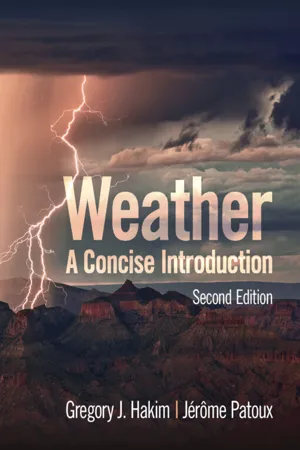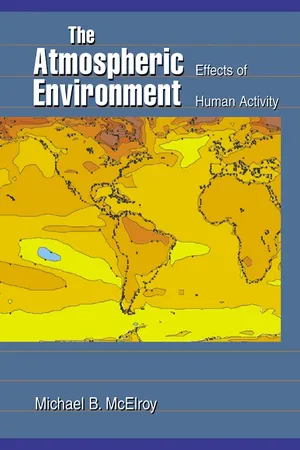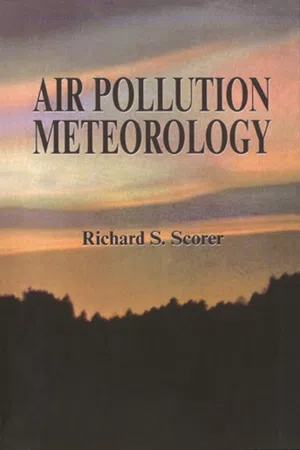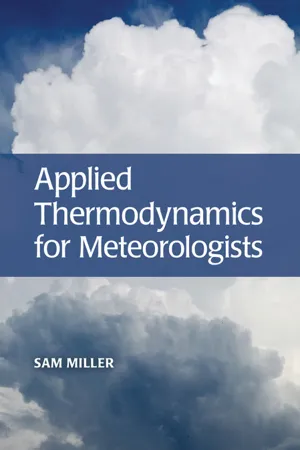Technology & Engineering
Adiabatic Lapse Rate
The adiabatic lapse rate refers to the rate at which the temperature of a parcel of air changes as it rises or descends in the atmosphere without exchanging heat with its surroundings. The dry adiabatic lapse rate is approximately 9.8°C per kilometer, while the moist adiabatic lapse rate varies depending on the moisture content of the air. Understanding these rates is crucial in meteorology and atmospheric science.
Written by Perlego with AI-assistance
Related key terms
1 of 5
9 Key excerpts on "Adiabatic Lapse Rate"
- eBook - PDF
Weather
A Concise Introduction
- Gregory J. Hakim, Jérôme Patoux(Authors)
- 2021(Publication Date)
- Cambridge University Press(Publisher)
6.3 Dry Adiabatic Lapse Rate The vertical structure of the atmosphere is relatively well known. It is known on average (see Figures 1.7 and 3.6, for example), and it can be known in detail on any given day by releasing a radiosonde, which makes measurements on its way up through the atmos- phere. We mentioned in Chapter 3 that the environ- mental lapse rate (the rate at which temperature decreases with height) is about 6.5 C/km on average, but that it can be very different on any given day and at any given location. The environmental lapse rate is set up by a mix of radiative and convective processes, as well as horizontal air motion (i.e., advection). Since we know the rate at which pressure decreases with height, we can calculate the work that the air parcel does as it is lifted above the surface, and therefore the rate of temperature decrease (see Box 6.2). The rate of temperature decrease due to adiabatic lifting and expansion is called the dry Adiabatic Lapse Rate and is about 10 C/km (or 5.5 F/1000 ft) for unsaturated air. (We will deal with moisture and saturation shortly.) Note, and this is an important point, that the con- cept of an Adiabatic Lapse Rate applies to air inside the parcel, which is different from the concept of an envir- onmental lapse rate outside the parcel. When establish- ing an environmental temperature profile and calculating an environmental lapse rate, we are simply measuring temperature at each altitude with a therm- ometer. Keep in mind that this vertical temperature structure is determined by several processes, including radiative and convective processes, as well as advec- tion. When calculating the dry Adiabatic Lapse Rate, however, all that matters is that the air parcel is rising and losing energy as it works against the surrounding environment during expansion (Figure 6.2). - eBook - PDF
- Hurd C. Willett, Frederick Sanders(Authors)
- 2013(Publication Date)
- Academic Press(Publisher)
This latter rate may or may not be the same as the prevailing lapse rate. The lapse rate is considered as positive, i.e., the temperature lapses with height, when the temperature decreases upward. The lapse rate of the lower atmosphere is usually, but not always, positive. The lapse 1 See B. Haurwitz, Dynamic Meteorology, pp. 45-49. 22 DESCRIPTIVE METEOROLOGY rate is referred to as steep when the condition is one of rapid decrease of temperature with elevation, and as small when the decrease of temperature with elevation takes place slowly. A condition of increase of temperature with elevation or of a negative lapse rate is referred to as an inversion of temperature or simply as an inversion. The lapse rate of potential temperature can be given by άθ/dz = (6/T)(dT/dz + ), where is the dry adiabatic rate, a 1° C/100 m. Two particular lapse rates are defined in terms of the dry and of the saturated adiabatic rates of cooling, on account of their significance as limiting conditions of the different degrees of the vertical stability of the atmosphere. The dry Adiabatic Lapse Rate is defined as a vertical temperature distribution such that any unsaturated particle of the atmosphere which undergoes adiabatic vertical displacement finds itself at every level at the same temperature as its surroundings. In other words, the temperature of the atmosphere must be observed to fall off by approximately one degree per hundred meters increase of elevation. The saturated Adiabatic Lapse Rate, frequently referred to as the moist Adiabatic Lapse Rate, is defined as a vertical temperature distribution such that any saturated particle of the atmosphere which undergoes adiabatic vertical displacement finds itself at every level at the same temperature as its surroundings. It follows that the saturated Adiabatic Lapse Rate is always less than the dry Adiabatic Lapse Rate, but it is not linear and it approaches the dry adiabatic as a limit at low temperatures. - Alok Kumar Patra(Author)
- 2020(Publication Date)
- NEW INDIA PUBLISHING AGENCY (NIPA)(Publisher)
Adiabatic changes in air temperature occur due to changes in pressure of the air while not adding or subtracting any heat. Due to the increase in pressure on a descending parcel of air, the parcel’s volume decreases and its temperature increases, thus increasing the internal energy. Adiabatic heating occurs when the pressure of an air parcel is increased from work done on it by its surroundings. Similarly, adiabatic cooling occurs when the pressure of an air parcel is decreased due to the work done on it by its surroundings. When the pressure applied on a parcel of air decreases, the air in the parcel is allowed to expand; as the volume increases, the temperature falls and internal energy decreases. The rate at which the temperature changes as air rises or falls is called Adiabatic Lapse Rate. If a parcel of air is lifted upward, its pressure is decreased, and its temperature falls due to the expansion. If the air is dry or unsaturated ( i.e ., relative humidity below 100 per cent) and the process is adiabatic, the rate of temperature fall is 10° C/km of lift. If that parcel descends again to higher pressure, its temperature increases at the rate of 10° C/km. This is known as dry Adiabatic Lapse Rate. When a mass of air is lifted, it cools at the dry Adiabatic Lapse Rate of 10° C/ km as long as it remains unsaturated. If the original moisture is being carried along with the mass as it ascends and it cools to its saturation temperature, the relative humidity reaches 100 per cent. Condensation takes place with further cooling. For each gram of water condensed, about 597 calories of heat is liberated. This latent heat of condensation is absorbed by the air, and the adiabatic cooling rate is decreased to 5° C/km instead of 10° C/km. The process during the saturated expansion of the air is called saturation adiabatic, the moist adiabatic or wet Adiabatic Lapse Rate.- eBook - PDF
The Atmospheric Environment
Effects of Human Activity
- Michael B. Mcelroy(Author)
- 2021(Publication Date)
- Princeton University Press(Publisher)
In the absence of condensation, the heat supplied is negligible (Q = 0) and the temperature lapse rate de- rived from (7.32) assumes the simple form ΔT Δz = − g c p (7.33) We refer to the rate of change of temperature with altitude defined by (7.33) as the dry Adiabatic Lapse Rate. The term p R R + R V = 4R 2 R p p p p R p p p W = (F)(S) = (p)(area)(R) = (p)(4R 2 R) = p V Figure 7.7 Illustrating the work done by a gas corresponding to a change in volume. adiabatic, as used in thermodynamics, identifies a process taking place in the absence of exchange of heat with the sur- roundings (Q = 0). Values of g, c p , and dry Adiabatic Lapse Rates computed for atmospheres of a number of planets of the solar system, including Earth, are presented in Table 7.1. Lapse rates are quoted here as positive numbers. Remember that use of the word lapse presupposes that temperature must decrease with altitude. The dry Adiabatic Lapse Rate for Earth is equal to 9.8 K km –1 . If condensation occurs, heat is released and Q is pos- itive. Under such circumstances, the decrease of tempera- ture with altitude is less than would be the case for a dry adiabatic process, as indicated by equation (7.32). We refer to the decrease of temperature with altitude for a rising air mass undergoing condensation as the moist Adiabatic Lapse Rate. The significance of condensation as a source of heat for the rising air mass depends on the quantity of H 2 O available for condensation; therefore, it depends ultimately on temperature. The moist Adiabatic Lapse Rate is about 3ºC km –1 for a temperature of 40ºC near the surface. It in- creases to about 6ºC km –1 as temperature drops to the freezing point, 0ºC. Values for the moist Adiabatic Lapse Rate as functions of temperature and altitude are presented in Table 7.2. - eBook - PDF
Weather
A Concise Introduction
- Gregory J. Hakim, Jérôme Patoux(Authors)
- 2017(Publication Date)
- Cambridge University Press(Publisher)
That is because, finding itself in an environment where the pressure is greater, the air inside the parcel is being compressed. The surrounding air now performs work on the parcel, which results in an increase in tem- perature (Figure 6.3). This is exactly the same process as the bike pump example, where the pump warms as we increase the pressure in the tire. formation of a cloud when air rises? What are the envi- ronmental factors that control the formation of clouds? Before we answer these questions and continue our exploration of cloud formation, let us have a quantita- tive look at adiabatic expansion. 6.3 Dry Adiabatic Lapse Rate The vertical structure of the atmosphere is relatively well known. It is known on average (see Figures 1.6 and 3.2, for example), and it can be known in detail on any given day by releasing a radiosonde, which makes meas- urements on its way up through the atmosphere. We mentioned in Chapter 3 that the environmental lapse rate (the rate at which temperature decreases with height) is about 6.5 °C/km on average, but that it can be very different on any given day and at any given loca- tion. The environmental lapse rate is set up by a mix of radiative and convective processes, as well as horizontal air motion (i.e., advection). Since we know the rate at which pressure decreases with height, we can calculate the work that the air par- cel does as it is lifted above the surface, and therefore the rate of temperature decrease (see Box 6.2). The rate of temperature decrease due to adiabatic lifting and expansion is called the dry Adiabatic Lapse Rate and is about 10 °C/km (or 5.5 °F/1000 ft) for unsaturated air. (We will deal with moisture and saturation shortly.) Note, and this is an important point, that the con- cept of an Adiabatic Lapse Rate applies to air inside the parcel, which is different from the concept of an envi- ronmental lapse rate outside the parcel. - eBook - PDF
Atmospheric Chemistry and Physics
From Air Pollution to Climate Change
- John H. Seinfeld, Spyros N. Pandis(Authors)
- 2016(Publication Date)
- Wiley(Publisher)
As a result, the rate of decrease of temperature of a rising air parcel in which water vapor is condensing will be less than that of a dry parcel. (We reiterate that “ dry ” in the present context refers to a parcel that may contain water vapor but in which water vapor is not condensing). The lapse rate of a saturated air parcel is called the moist Adiabatic Lapse Rate and is given the designation Γ s . 676 PHYSICAL AND DYNAMIC METEOROLOGY The dry Adiabatic Lapse Rate is the temperature pro fi le of an adiabatically rising air parcel that can contain water vapor but for which the water vapor is not condensing. We now derive the analogous lapse rate for an air parcel in which water vapor is condensing. Whereas the dry Adiabatic Lapse Rate is constant (9.77 ° C km 1 ), the moist Adiabatic Lapse Rate depends on the moisture content of the air, and it can vary from ∼ 4 ° C km 1 to nearly the dry value. The greater the moisture content of the air, the more latent heat that can be released when condensation occurs. The dry and wet adiabats become nearly the same in the upper troposphere because very cold air does not hold much water vapor, and, therefore, only a small amount of latent heat can be released. To derive the expression for the moist (saturated) Adiabatic Lapse Rate, we apply the fi rst law of thermodynamics to an air parcel saturated with water vapor. As in the dry case, in deriving the equation for the moist adiabat, we assume that the atmospheric temperature pro fi le is the same as that in the adiabatically lifted saturated air parcel. (This need not be the case, but it simpli fi es the derivation.) For the dry air parcel undergoing an adiabatic change, dq = 0. In the saturated parcel, dq is nonzero and is equal to the source of heat from the condensing water vapor. - eBook - PDF
- R R Scorer(Author)
- 2014(Publication Date)
- Woodhead Publishing(Publisher)
110 The Technical Dictionary [Ch.6 The value of R is 2.8703 10 6 ; and for dry air in cgs units C p = 0.2396, C v = 0.1707, so that γ = 1.403 (6) and so with g = 980.6 cgs, the dry Adiabatic Lapse Rate is -Γ = 9.86°C per km. For practical purposes, and within the accuracy of usual measurements of temperature we may say that in a well-mixed neutrally stratified atmosphere the lapse rate is DALR = PC per 100 metres. This means that heights (layer thickness) between isobars on the tephigram may be estimated as 100 m for each 1°C along the adiabatic line from one to the other. Aerodynamic Diameter The aerodynamic diameter of a particle in the atmosphere is the diameter of a spherical particle of unit density that has the same fall speed in air as the particle. This is a convenient way of discussing the particles of different origin, the fall speed being the most important distinguishing feature. There are some particles for which this is not a good distinguishing feature, the most important being asbestos which consists of many very thin fibres and may have very serious effects if it becomes embedded in flesh. It is particularly dangerous if it penetrates into the alveoli of the lungs, or any part of the bronchial system. Aerological Diagram and The Tephigram A diagram convenient for displaying the information obtained from a sounding of the atmosphere, from which useful calculations can be made, has T and In p (temperature and logarithm of pressure) as rectangular co-ordinates. These are widely used routinely in some national meteorological services, and are called the T - log p 9 diagram. But it is considered more convenient to give the adiabatic changes prominent status as a reference rate of change with the same slope everywhere on the diagram, and this is done by using entropy as the second co-ordinate denoted by φ in the place of the logarithm of pressure. This is - eBook - PDF
- Sam Miller(Author)
- 2015(Publication Date)
- Cambridge University Press(Publisher)
The full derivation of the Moist Adiabatic Lapse Rate is given in Appendix 7 ; so here we will only list the simplifying assumptions and show the result. It’s important that you understand the assumptions (i.e., the weaknesses in the model) before you use this result. They are: • We assume an isolated, compound parcel, with water vapor coexisting in equilibrium with liquid water. The two halves of the compound parcel are open to each other, and consist of (1) liquid water and (2) water vapor mixed with dry air, but are isolated from the surround-ing environment. • We assume that, as vapor condenses, the resulting liquid water drops remain inside the compound parcel, so that when they evaporate again, they can take up exactly the same amount of latent heat that they release when they condense. This makes the processes reversible and allows the heat to be conserved. That is, the Moist Adiabatic Lapse Rate is a model of heat conservation. • We assume that the combined mass of the parcel’s vapor and dry air is equal to one kilogram. • We assume that all latent heat released during condensation is taken up by the parcel’s dry air , and none of it goes into the parcel’s remaining load of water vapor. • We assume that the total atmospheric pressure ( p ) is much greater than the saturation vapor pressure ( e s ), so that p – e s ≅ p . • We assume that w s = e s ε /p , and equivalently, that e s = pw s / ε . • Finally, we assume that temperature varies only as a function of elevation. - eBook - PDF
Hydrology and Hydroclimatology
Principles and Applications
- M. Karamouz, S. Nazif, M. Falahi(Authors)
- 2012(Publication Date)
- CRC Press(Publisher)
The air is then unstable if it becomes saturated or, in more general form, when the ambient lapse rate is more than the Adiabatic Lapse Rate. Conditional instability happens when the ambient lapse rate lies between the dry and moist rates. In Figure 3.7, the stable and unstable conditions of weather are shown. Consider Figure 3.7a, which shows an ambient temperature profile for air that cools more rapidly with altitude than the dry Adiabatic Lapse Rate. Imagine a 20°C parcel of air at 1 km to be just like the air surrounding it. If the parcel is raised to 2 km, it will cool adiabatically to 10°C. The 10°C parcel of air at 2 km is now warmer than the surrounding air (0°C in Figure 3.7); hence, it is less dense, is more buoyant, and will keep rising. Conversely, a parcel of air at 1 km that is nudged downward becomes colder than the surrounding air, and so it keeps sinking. It does not matter whether the parcel of air is nudged up or down; in either case, it keeps on going, and the atmosphere is said to be unstable. In Figure 3.7b, the ambient temperature profile is drawn for a case in which the ambient temperature cools less rapidly than the Adiabatic Lapse Rate, which corresponds to atmosphere stability. In this situation, anything that starts a parcel of air moving up or down will cause the parcel to experience forces that will want it to return to its original altitude. Figure 3.8 shows a summary of how lapse rates determine atmospheric stability. If the ambient lapse rate shows cooling at a faster rate than the dry Adiabatic Lapse Rate, Γ d , such as line A in Figure 3.8, the atmosphere is absolutely unstable in region A. The air will always have a tendency to move 4 3 2 1 0 –10 0 10 2 0 30 1 km Altitude (km) Temperature (°C) Γ d Γ s 10°C FIGURE 3.6 Dry, Γ d , and saturated, Γ s , adiabatic rates. 71 Hydroclimatic Processes to some new altitude, enhancing the vertical dispersion of pollution.
Index pages curate the most relevant extracts from our library of academic textbooks. They’ve been created using an in-house natural language model (NLM), each adding context and meaning to key research topics.








